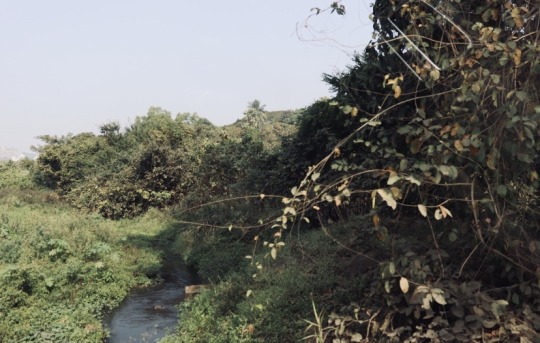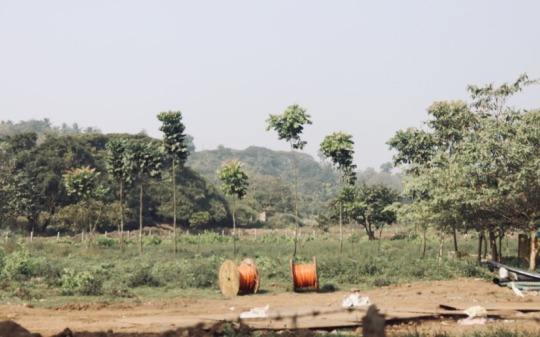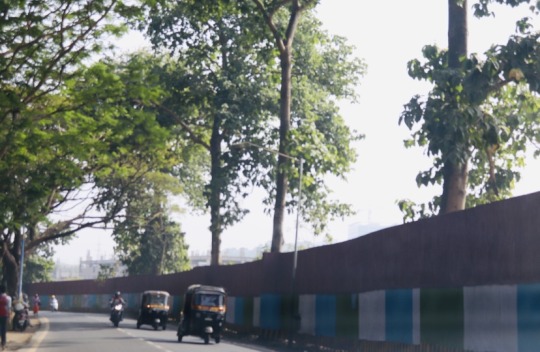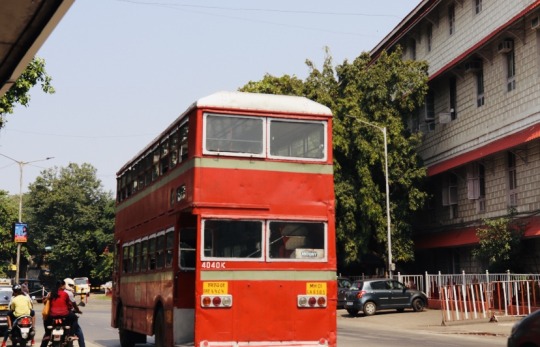Text
THE AAREY vs METRO SAGA
CHAPTER ONE: THE FADNAVIS & THACKERAY ERA
What is Aarey?
The Aarey Milk Colony was established in 1949 as a government dairy farm on 1,287 hectares of land and was inaugurated by the then Prime Minister Pandit Jawaharlal Nehru in 1951. Over the years, the land has been diverted for other uses. A major portion of its green cover has been lost to new construction projects like the housing colony built by the Maharashtra Housing and Area Development and Film City.
Wildlife experts have estimated that the area has 48 species of reptiles and 12 amphibian species and 80 butterfly and moth species. It also has 16 species of mammals like leopard, deer, boar, jungle cats and 90 different types of spiders. Many of these species are under the Wildlife Protection Act, 1972.

(A part of the Aarey Colony)
Aarey is an area which starts from Powai and extends all the way till the Western Express Highway in Goregaon. It used to be a part of the Sanjay Gandhi National Park before being opened for commercial purposes and was again declared as a reserve forest. There are at least 27 tribal communities also residing in the colony, making it home to over 3,500 families of Warli Adivasis and other tribal groups that face displacement now.
What is the Issue?
The Save Aarey Movement was never against the metro being built, it was against the car shed which will be built in Aarey for the underground Colaba-Bandra-Seepz metro line. A metro car shed is where all the metro trains which will rest during the non-working hours. It is in the car shed that the trains will be washed, cleaned and repaired and maintained. It is the starting point for train operations every day.
The Colaba-Bandra-Seepz metro car shed is worth Rs 900 crores and Prime Minister Narendra Modi laid the foundation stone of the project on September 7, 2019. The MMRCL (Mumbai Metro Rail Corporation Limited) has earmarked 33 hectares (around 2%) of the Aarey Colony land for this car shed. The number of trees that fall in these 33 hectares of land is over 27,000.
The movement had started back in 2013 but found its momentum in the year 2019. Huge protests had erupted in Aarey Colony area in Mumbai on the night of October 4 and on October 5, 2019 when the MMRCL had begun to cut down trees for the Colaba-Bandra-Seepz Metro car shed.
After the Bombay High Court dismissed pleas opposing the decision to cut 2,646 trees for the Metro project on October 4th 2019, Mumbai civic authorities started cutting trees on a large scale at Aarey Colony. After this incident, the Bombay High Court ordered the petitioners to approach the Supreme Court and the National Green Tribunal. On October 7th 2019, the Supreme Court ordered the authorities and MMRCL to not cut down trees in the Aarey.
What is the current situation?
Ever since the Shiv Sena government came into power, the work on the Metro 3 car shed has been put on halt indefinitely. However, MMRCL has stated that 25% of the work for the metro shed is already completed, before the new government came into power. There are huge machines which lie idle at the construction site and ground leveling was also underway.
The entire area has been barricaded. Taking photographs and getting access to the construction site is not allowed and there is heavy security provided by the government. There are security guards at every entrance of the construction site and they do not allow people walking by to see what’s going on behind the barriers.
With the current government’s decision of halting the construction work on the metro shed, several other problems have surfaced. One of them being the Rs 4.3 crores loss occurring per day due to the delay. Till now there has been a total loss of Rs 270 crores on account of work stoppage. This decision will also decelerate the infrastructural projects in Mumbai. This would have a negative impact on the Central Government’s vision of ‘Make In India’.

(The construction work on hold)
Deven R Choksey, MD, KR Choksey, in an interview with Economic Times said, “State governments often cancel or stall projects granted during the last regime. This unnecessarily creates a huge amount of financial consequences for both investors as well as lenders, apart from raising the risk of defaulting by companies.”
He has further mentioned that these kinds of decisions will dissuade the corporates from taking up any more projects in the country. It will also dissuade the investors from coming to the country and from bankers to extending credit.
The new Maharashtra government has suggested about relocating the car shed to Goregaon’s SRPF (State Reserve Police Force) Ground. The State Government had set up a new panel to look into the Aarey issue and see if they could relocate the car shed to another area. The panel came up with same problems which were mentioned by the previous government of unavailability of land, financial implications, technical and operational difficulties.

(An aerial view of the construction site from the JVLR flyover)
If the State Government has to relocate the metro shed to Kanjurmarg, which is 7kms away from the last metro 3 station, Seepz, the trains would have to make dead trips to reach the depot. The metro line has been planned for a service frequency of 2 minutes and if the depot is shifted the crowd will increase at the station and thus will lead to defeating the very purpose of the metro. And there would be a Rs 1,700 crores cost escalation if the metro shed has to be relocated to another location.
CHAPTER TWO: CLIMATE VS DEVELOPMENT
CLIMATE
During the BJP led State Government, the then Chief Minister, Devendra Fadnavis’ standard response to the Aarey issue was ‘will grow more trees.’ He believed that trees had to be cut as development is also important.
According to a Firstpost article, “South Asian countries today are at a delicate threshold facing severe extreme weather conditions. A Global Climate Risk Index released at the Katowice Summit in Katowice, Poland, in 2018 showed that intense cyclones, excessive rainfall, and severe floods could make India and its neighbours among the worst affected countries in the world.”
India has resorted to afforestation without consulting local communities or conducting serious studies on it. As the Adivasi activist from Aarey Prakash Bhoir says, "The way most of these afforestation drives work is illogical and unscientific. How can you plant twenty-five trees at a mere spacing of a foot or less? What happens to the trees when they grow up? This proves that the approach is incorrect. Most of the saplings planted during afforestation projects die in this manner."

(A dry patch in Aarey)
An activist by the name Zoru Bhathena, who is representing petitioners in the Aarey tree felling case claimed that a substantial number of trees planted by the MMRCL during the work of Mumbai Metro 3 project are already dead. Later, the MMRCL itself admitted that only 36 per cent of the trees transplanted have survived. In a statement by a spokesperson of the MMRCL said that it transplanted 1,582 trees and 36 per cent of them i.e. 572 have survived.
There is evidence that afforestation programs may not be sufficient enough to reduce the climate crisis.
China's "The Sloping Land Conversion" program, one of the largest reforestation programs in the world aimed at "protecting biodiversity and improving environmental conditions", had a negative impact on the natural forests in the area after 13 years of implementation. Researchers found out that the rubber and pulpwood plantations had replaced natural forests on sloping lands. With the sharp increase in these plantations, the natural forests, shrubs and bushes decreased and were converted into pulpwood plantations. There is danger of carbon stock increasing if natural forests are replaced in this manner.
The article further stated that, “Researchers who examined 260 years of changes in European forest management found that despite a 10 percent increase in wooded land, the continent's forests have actually caused a slight increase in regional temperatures since 1750. This was attributed specifically to a shift from broad-leaved tree species like oak to more economically valuable conifer species like spruce and pine, which absorb more sunlight.”
Planting a sapling is the easiest part to regain green cover. The challenging part is the maintenance of the newly-planted saplings and ensuring that the saplings become robust trees. Most studies have found that survival rate of saplings is never 100 percent. Researches in Indianapolis and Philadelphia, which looked at street trees in the city of Detroit, found that high survival rates are critical during the first three years.

(A part of Metro shed which has been barricaded)
In Aarey the car shed is expected to consume an estimate of 50,000 litres of groundwater everyday for washing the metro. The residents of the Aarey Colony are worried that the car shed project will open the doors to other infrastructural projects too.
The cutting down of trees also leads to the increase in air pollution. As Mumbai doesn’t have a vast green cover, cutting down these trees will have an impact on both present and future generations. The World Health Organisation (WHO) suggests that air pollution is capable of affecting the health of people.
As mentioned earlier the Aarey forest is home to many species like leopards, deer, boars, jungle cats, reptiles and amphibians. Taking over the 33 acres of land to make a metro shed puts the habitat of the animals in danger. There have been many cases of leopard sightings in Mumbai, where these animals are found roaming on the streets of the city.
With the increase in the number of leopards in the Sanjay Gandhi National Park, it would be a lot more difficult to keep these animals in their habitat if the people keep cutting down trees to make infrastructural projects.
DEVELOPMENT
When it comes to development, Mumbai, one of the world’s densely populated cities with a population of 18.14 million people (as per Census 2011) accounts for slightly more than 6.16% of India’s economic growth. Mumbai’s public transport system consists of a suburban Indian rail network (Central, Western, Harbour), bus services as well as private black-and-yellow taxis, Uber and Ola services and autorickshaws.
The suburban rail network carries over 7.5 million commuters and public buses operated by Brihanmumbai Electric Supply and Transport (BEST) service carry about an approximate 3.65 million commuters every day.

(A double-decker BEST bus in Churchgate)
However, the quality of public transport infrastructure in Mumbai is on a rapid decline, which affects the time and energy spent by the citizens. Being one of the most important mode of transport, the railway network faces numerous challenges. The trains are already bursting with passengers at the peak hours.
According to an article by Youth Ki Awaaz, “In the last 10 years, 25,722 people have fallen off moving trains, of which 6,989 people died due to losing their grip while trying to get into a jam-packed boogie or hitting an electric pole while in motion. There have been alarming cases of deaths due to suffocation, heart attacks and seizures triggered due to a fatal drop in oxygen levels.”
The buses are unreliable as they get stuck during the peak hour traffic. The rickshaw walas and private taxi walas keep rejecting the travelers and Uber and Ola taxis are way too expensive for the common people of Mumbai. Hence, the need for metro.
The ticket price for the Mumbai metro varies from Rs 20 – 50 which is affordable for the common man. It is comparatively cheaper than autorickshaws and private taxis. Furthermore, the metro project will reduce the 2.5 lakhs metric tons of carbon footprint every year. As it will take out more than 50% of the vehicles from the roads such as autorickshaws, private cars and taxis. It will also reduce the number of people traveling in the suburban rails and BEST buses.
CHAPTER THREE: JANTA & ACTIVISTS KI SOCH
Views of the public:
https://drive.google.com/open?id=1rC6zJUG2UmfaGhJ4oywfA-Qoge0EWtqV
Interview with Reema Sushnar (Activist):
https://drive.google.com/open?id=1bs3fh3n88BTx-vXLt2pU-yfl35E0vmNn
Some of the points that can be taken from the above videos are the clear distinction between the thoughts of the general public and that of the activists and environmentalists. The general public are worried more about the money the government is losing due to the delay in the project. They are also more focused on their convenience and how they could save their time. As long as the trees are transplanted and afforestation happens, they are satisfied with the project.
The activists and environmentalists on the other hand would choose the lungs of Mumbai i.e. Aarey over development. They believe that the Metro 3 will not reduce the carbon emissions as it is an underground metro and will run on thermal power. They also believe that the metro reducing the number of vehicles on the road is just an assumption, as the rich would still prefer to travel in their own cars, the poor won’t be able to afford the ticket prices for the metro and will stick to the BEST buses and suburban rails.
CHAPTER FOUR: CONCLUSION
The fact is, the damage is already done. The previous regime had already taken over the 33 hectares of the land, begun the work and has completed 25 percent of it. To relocate the car shed to another area will just escalate the cost and increase the time overrun. Every delay would cause the exchequer several crores per day. As it is, the metro project is already delayed by a year and the effects caused by it cannot be reversed.
Unfortunately, the Aarey car shed has become a sore spot for both the political parties, that is, BJP and Shiv Sena respectively. The newly appointed panel of the Shiv Sena has also mentioned the same issues which were being faced by the BJP panel. And in the slug fest between the two parties the Mumbai citizens are the losers.
When it comes to afforestation, the government should not use fast growing trees as they have a negative impact on the environment. These trees are generally dry and can quickly catch fire. They also absorb large amount of the minerals from the soil and groundwater. This affects the growth of other trees in that area. Instead the government should plant native or indigenous trees. They should look into replanting trees like Dhaman, Shemat, Bhokar, Kahandal, Apta, Shivan and Subabul as these are some of the native and common trees found in Aarey.
BIBLIOGRAPHY AND REFERENCES
1. https://www.indiatoday.in/india/story/over-60-trees-transplanted-by-mmrcl-dead-claims-aarey-activist-1620745-2019-11-20
2. https://www.dailyo.in/variety/aarey-forest-mumbai-metro-rail-bjp-shiv-sena-wildlife-protection-act-biodiversity-conservation-maharashtra-assembly-polls-2019/story/1/32110.html
3. https://www.thehindu.com/news/cities/mumbai/bmc-gets-82000-objections-to-tree-cutting-for-metro-car-shed/article28325173.ece
4. https://www.indiatoday.in/india/story/aarey-milk-colony-tree-felling-supreme-court-mumbai-metro-construction-1607037-2019-10-07
5. https://qrius.com/the-save-aarey-activists-who-are-they-really/
6. forbesindia.com/article/special/bombay-hc-dismisses-pleas-to-save-aarey-forest-tells-petitioners-to-approach-sc/55591/1
7. https://scroll.in/article/937002/saving-aarey-why-a-city-with-a-weak-protest-culture-is-demonstrating-to-protect-mumbais-green-lung
8. https://www.firstpost.com/india/movement-to-save-aarey-forest-effects-of-climate-change-need-nuanced-interventions-afforestation-isnt-enough-7477091.html
9. https://timesofindia.indiatimes.com/city/mumbai/toi-confirms-trees-gone-at-aarey-site-metro-says-25-percent-of-work-done/articleshow/72376131.cms
10. https://timesofindia.indiatimes.com/city/mumbai/shadow-over-metro-three-after-maharashtra-cm-uddhav-thackerays-aarey-stay/articleshow/72301920.cms
11. https://www.pressreader.com/india/the-times-of-india-mumbai-edition/20191203/281590947430690
12. https://www.dailyo.in/variety/aarey-forest-mumbai-metro-rail-bjp-shiv-sena-wildlife-protection-act-biodiversity-conservation-maharashtra-assembly-polls-2019/story/1/32110.html
13. https://www.urbantransportnews.com/mumbai-needs-metro-here-are-the-facts-about-aarey-forest-and-mumbai-metro/
14. https://www.firstpost.com/india/movement-to-save-aarey-forest-effects-of-climate-change-need-nuanced-interventions-afforestation-isnt-enough-7477091.html
15. https://www.timesnownews.com/mirror-now/in-focus/article/cutting-down-of-trees-in-mumbais-aarey-forest-will-do-more-harm-than-we-know/484890
16. https://economictimes.indiatimes.com/markets/expert-view/investors-bankers-to-suffer-if-maharashtra-infra-projects-get-stalled-deven-r-choksey/articleshow/72349482.cms
1 note
·
View note